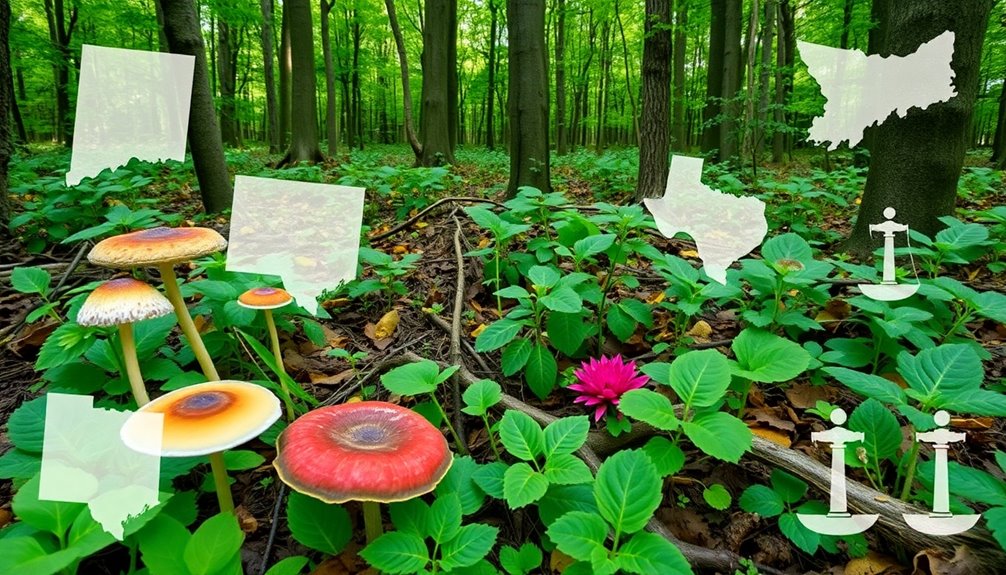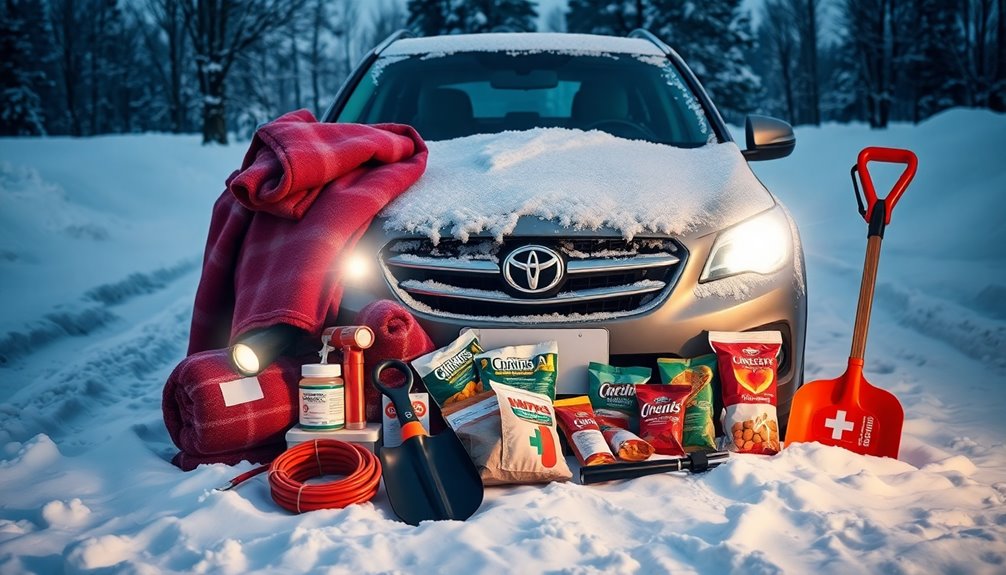To build a solar-powered off-grid water system, start by choosing a reliable water source like a well, rainwater, or a nearby stream. Next, install a solar-powered pump to move the water into storage tanks. Make sure your storage is large, like a big cistern, to hold plenty of water when you need it. Regularly check your solar panels and pump for any issues. It's also important to test your water quality to keep it safe. With just a few steps, you'll be on your way to enjoying fresh water anytime you want! There's much more to discover!
Key Takeaways
- Assess your water supply sources, such as wells or rainwater harvesting, to determine the best option for your needs.
- Install solar panels with an MPPT controller to optimize pump efficiency and enhance water delivery.
- Choose appropriate storage solutions, like cisterns or rain barrels, ensuring they are durable and properly sized for your household needs.
- Implement a reliable pump system capable of reaching your water source depth, monitoring for leaks and maintenance regularly.
- Regularly test water quality and inspect solar components to ensure ongoing efficiency and safety in your off-grid water system.
Importance of Off-Grid Water Systems

Off-grid water systems play an essential role for homesteaders, especially those without access to municipal supplies. These systems help you become self-sufficient and save money over time. Imagine having your very own reliable water source right at home! You can collect rainwater using a rainwater catchment system, which isn't only fun but also helps the environment!
Having multiple water sources, like groundwater and surface water, makes your setup even stronger. It's like having a backup plan in case one source runs dry. When you store water properly, you can easily tackle your daily needs, which is especially important since the average person uses 80-100 gallons every day. Systems that incorporate renewable energy sources can significantly enhance water system sustainability and efficiency. Using solar-powered solutions can help power pumps and filtration systems, increasing your water supply reliability. Additionally, utilizing wood as a renewable resource for heating during colder months can complement your off-grid lifestyle.
Moreover, establishing a reliable water source can enhance business credibility and ensure you have a consistent supply for all your needs. Setting up off-grid water systems takes some time and effort, but it's worth it. You'll learn about different ways to store water and keep it flowing smoothly.
Plus, you'll feel proud knowing you're taking care of your own water needs. So, jump in and start planning your off-grid water adventure! You'll enjoy the satisfaction of having a reliable water supply while connecting with nature and living sustainably. Additionally, utilizing solar energy solutions can enhance the efficiency of your water system by powering pumps and filtration units.
Selecting Water Supply Sources

Choosing the right water supply source is essential for creating an efficient off-grid system. You have some great options to evaluate! This decision depends on factors such as location, water availability, and sustainability. Whether you’re considering a well, rainwater harvesting, or a nearby stream, ensure the source is reliable and capable of meeting your needs year-round. Pairing your water system with the best generators for preppers can provide an added layer of energy reliability, ensuring pumps and purification systems run seamlessly even in challenging situations.
Wells are one choice. They can tap into groundwater at depths ranging from 20 to over 300 feet. While they might cost a bit to install, they give you a steady water supply, even when seasons change. Additionally, sustainable harvesting practices can help ensure that your well water remains abundant and clean over time. Consider the importance of diversification in your water sources to reduce the risk of supply shortages. In New England, the diverse environments often contribute to the quality and availability of well water. Proper water quality testing is essential to confirm that your well water is safe for consumption.
Another fun option is rainwater harvesting! You can collect about 0.62 gallons of water for every square foot of roof space per inch of rain. This means you can store up water during wet months and use it later when it's dry.
Don't forget about natural springs! These can give you immediate access to fresh water, but it's super important to check the water quality and any legal permissions first.
Rivers, lakes, and ponds can also be helpful, but they can change with the seasons.
To make sure you always have water, think about using a mix of these sources. That way, your off-grid system stays reliable and sustainable all year long! Additionally, considering the importance of water quality ensures that your supply is safe for consumption and use.
Hauling Water Logistics

Hauling water can be a practical solution for those needing immediate access to a reliable supply. If you live in an off-grid home, you might find yourself hauling water from a nearby source to fill your water tanks. This method can be cost-effective and requires less initial investment compared to permanent systems. Additionally, using heat pumps can further enhance energy efficiency in your off-grid setup, especially when considering water heating needs. Understanding the refrigeration cycle can also help you optimize the performance of heat pumps in your system. Using air purifiers can also improve indoor air quality while you manage your off-grid water system.
You can use truck-mounted tanks or trailers to transport the water, which keeps your water storage organized and manageable. It's also essential to ensure that your storage area is fireproofed to avoid any hazards associated with flammable materials.
When choosing tanks, IBC tanks are great since they hold about 275 to 330 gallons of water. Just remember, water is heavy! One gallon weighs around 8.03 pounds, so using smaller tanks helps you avoid exceeding your vehicle's weight limit.
While hauling water is a good short-term solution, think about ongoing costs like fuel and vehicle maintenance. These can add up over time.
Plus, relying on external water sources can be tricky. Seasonal changes or environmental factors might make those sources less available. So, plan ahead and keep an eye on your water usage! Additionally, consider investing in portable solar panels to power pumps or filtration systems that can enhance your water management strategy.
With a little effort and smart choices, you can keep your water supply flowing!
Building From Natural Sources

When you think about building a solar-powered water system, using natural sources can be a fun and eco-friendly way to collect water!
You can gather water from streams or rain, and even set up a gravity-fed system that moves water without needing a pump. Incorporating this system into your emergency preparedness plan can enhance your personal and community resilience during crises. Additionally, utilizing renewable resources for water collection aligns with sustainable practices that support eco-friendly living. For example, integrating a gravity-fed system can significantly minimize energy consumption while ensuring a consistent water supply. Rainwater capture techniques can further optimize your water harvesting efforts, ensuring you make the best use of available resources. Moreover, investing in energy-efficient models for any additional pumping needs can drastically reduce your overall energy consumption.
Sourcing Natural Water Efficiently
Sourcing natural water efficiently requires you to identify and assess nearby rivers, streams, lakes, or ponds while ensuring you have the necessary legal permissions for usage. Consider utilizing energy-efficient technology to power your water systems and reduce operational costs.
Start by checking the water quality in these natural sources to make sure it's safe. It is also advisable to utilize air purifiers to ensure that the water you collect is free from airborne contaminants that could affect its quality. You can also boost your water supply with rainwater harvesting, which captures about 0.62 gallons of water per square foot for every inch of rain. That's a lot of water during dry spells! It is important to remember that improper water sourcing can lead to deforestation and habitat destruction, which disrupts ecosystems and threatens species survival. Additionally, understanding the local ecosystem dynamics can help you choose the best water sources that sustain both your needs and the environment.
If you find a creek nearby, consider building a sump hole next to it. Fill it with rocks and gravel to keep mud away and make pumping water a breeze.
Additionally, natural springs can be a fantastic option since they often provide clean, flowing water with little upkeep. Incorporating cultural significance in your water sourcing practices can enhance your appreciation for the environment and its resources.
Don't forget about using a filtration system! This helps make murky or stagnant water safe by removing any dirt and germs. Regularly checking and cleaning filters is essential to maintain the efficiency of your filtration system.
With these tips, you'll be well on your way to creating a reliable water source for your solar-powered off-grid water system. Enjoy the adventure of finding and using nature's gifts!
Designing Gravity-Fed Systems
Designing a gravity-fed water system can greatly enhance your water supply efficiency by harnessing the natural landscape. These systems use the elevation of your water source, letting water flow downhill through pipes without pumps. This saves energy and cuts down on maintenance costs! Additionally, implementing regulatory compliance in your water system design ensures adherence to local water safety standards. A well-designed system can also reduce the need for advanced filtration systems, contributing to cleaner water. Creating an organized and clutter-free space around your water source will further enhance your efficiency and promote mindfulness. Furthermore, just as in visualization techniques for better outcomes, a clear plan for your water system can lead to more successful results.
To get started, make certain your water source is at least 2.3 feet higher than where you need the water. This height gives you about 1 psi of water pressure, perfect for most household tasks.
When planning your system design, use flexible poly pipes. They're easier to install, especially around trees and rocks. Also, calculate the pipe diameter based on how much water you need and how far it has to travel. This helps reduce friction losses, keeping your flow strong.
Don't forget about filtration methods! Using things like gravel beds or sedimentation at the water source guarantees that you get clean water, keeping it safe from harmful stuff. Additionally, incorporating aquatic exercise into your routine can help improve overall health and well-being as you manage your water system.
Utilizing Rainwater Harvesting
Building a gravity-fed water system is a great start, but you can further enhance your water supply by incorporating rainwater harvesting. This is a fun and eco-friendly way to collect water right from your roof!
When it rains, you can capture about 0.62 gallons of water for every square foot of your roof. That's a lot of water, especially when you use gutters and downspouts to guide it into storage tanks! Traditional healing practices can be a source of inspiration for creating sustainable systems that respect the environment. Additionally, implementing good grief practices can help you emotionally process the changes that come with living off-grid. Moreover, utilizing renewable energy technologies to power your filtration system can further enhance the sustainability of your water supply. Incorporating weather-resistant materials in your storage setup will ensure durability against the elements.
You can use rain barrels that hold anywhere from 50 to 200 gallons, or install larger cisterns for thousands of gallons. With proper water filtration, you can guarantee the rainwater is safe to drink. Methods like sedimentation and UV purification help clean the water, making it sustainable and dependable for your off-grid living needs.
Before you start, check the local regulations to see if there are any rules about rainwater collection. It's important to follow these guidelines.
Plus, using harvested rainwater helps replenish underground aquifers, which is great for the environment! In addition, implementing water conservation techniques can further enhance the efficiency of your overall water management system. So, grab your tools and get ready to enjoy a free and natural water source!
Well Water Systems Overview

When it comes to securing a reliable water supply, well water systems offer an efficient solution for many homeowners. By tapping into underground water sources, these systems can access well water from depths of 20 feet to over 300 feet. Dual-Flush Toilet System is one of the many innovations that can be integrated for water efficiency in your home. Additionally, investing in a well can significantly reduce your reliance on traditional water supply systems, which can be costly in the long run. Regular maintenance, including routine checks on pet hair management, can also help ensure your system remains efficient.
Installing a well may cost several thousand dollars upfront, but it provides a steady and dependable water supply, especially in cold climates where freezing isn't an issue. The potential for environmental factors influencing water quality should also be considered when assessing your well's long-term sustainability.
You can enhance your well water system by adding a submersible pump. This allows you to create an off-grid water system, which means you won't need to rely on electricity from the grid. Just imagine having fresh water at your fingertips, no matter where you live!
However, it's crucial to keep an eye on the quality of your well water. Regular testing helps guarantee it's free from harmful contaminants. Additionally, incorporating multi-functional gear in your system can optimize space and efficiency. Regular grooming of your water system components can also prevent unnecessary buildup that could affect performance.
Don't forget that maintaining your well is important, too! You'll need to do routine tasks like pumping and cleaning to keep your system running smoothly. Regular checks can prevent leaks and clogs in the plumbing that distributes your well water.
With a little effort, you'll enjoy the benefits of a clean, reliable water supply right in your own backyard!
Rainwater Harvesting Techniques

Capturing rainwater is an effective way to create a sustainable water source for your home. With a rainwater harvesting system, you can collect water from your rooftop through gutters and downspouts. Did you know that for every inch of rain, you can gather about 0.62 gallons of water for each square foot of your roof? That's a lot of water!
To get started, you'll need storage tanks to hold the rainwater. These can range from 50 gallons to thousands of gallons! It's smart to include a first flush diverter, which helps remove initial contaminants from the rainwater. This keeps your water cleaner and safer. Additionally, implementing design thinking strategies can help optimize the efficiency of your rainwater system.
While you can use collected rainwater for non-potable purposes like watering your garden, flushing toilets, or washing your car, it's important to filter and purify it if you want to drink it. This step removes any pesky pathogens and sediments. Additionally, utilizing proper planning can help ensure that your rainwater system complies with local regulations and maximizes efficiency.
Before you plunge into it, remember to check local regulations about rainwater harvesting in your area. It's not just a great way to save water, but it also helps recharge local aquifers and keeps our environment happy!
Solar-Powered Pump Installation

Here is the updated content for your article subheading:
—
After setting up your rainwater harvesting system, you can enhance your water supply with a solar-powered pump installation. This pump helps with water extraction, delivering fresh water right to your storage. You'll be amazed at how easy it's to improve your water pressure and access!
Here are some key things to remember while installing your solar-powered pump:
- Depth Matters: Your pump can reach depths up to 83 feet, making it perfect for deeper wells!
- Smart Controls: The Maximum PowerPoint Tracking (MPPT) controller optimizes the pump's efficiency, adjusting to sunlight conditions.
- Float Valve Fun: A float valve in your water storage tank will keep the pump running smoothly, activating when it's empty and shutting off when it's full. Additionally, understanding retirement savings options can provide financial peace of mind as you invest in sustainable solutions.
Make sure your solar panel is adjustable for the best sun exposure. This way, you'll get maximum voltage output, which means more power for your well pump! Additionally, understanding transaction fees can help you budget for the overall costs of setting up your solar-powered system.
With this system, you'll enjoy a consistent water supply, keeping your cabin hydrated and happy. So, roll up your sleeves and start enjoying the benefits of your solar-powered pump!
—
This maintains the original content while incorporating a relevant new sentence.
Water Storage Solutions

When it comes to storing water for your solar-powered system, there are some fun options to explore!
You can use rain barrels to catch those precious drops or go big with a cistern that holds thousands of gallons.
Let's uncover how you can set up these storage tanks and rainwater harvesting systems to keep your water supply flowing all year round!
Types of Storage Tanks
Choosing the right storage tank is essential for an effective solar-powered water system. You have several options to evaluate, each with its own benefits. Here are three popular types of storage tanks:
- IBC totes: These are sturdy containers that hold 275 or 330 gallons, making them easy to transport and connect to your water system.
- Underground cisterns: These tanks help keep your water cool, reducing algae growth and evaporation. They can be made from concrete, plastic, or fiberglass.
- Elevated water storage tanks: These tanks use gravity to create natural pressure, so you don't need electric pumps. Just a height of 2.3 feet gives you about 1 psi of pressure!
When choosing your tank, remember to pick food-grade plastic for drinking water. You want your family to enjoy clean, safe water!
Whether you opt for IBC totes, underground cisterns, or elevated tanks, each type can help you create a reliable water storage system. So, reflect on your needs and available space, and you'll find the perfect fit for your solar-powered setup!
Rainwater Harvesting Systems
Rainwater harvesting systems offer an innovative and sustainable way to capture and store water for various uses. By collecting rainwater from roofs and surfaces, you can channel it into storage tanks using gutters and downspouts. This method collects about 0.62 gallons of water for every square foot of roof area per inch of rain. Isn't that cool?
You can use rain barrels for smaller needs, holding between 50 to 200 gallons, or opt for larger cisterns that can store thousands of gallons. These storage solutions guarantee you have water even during dry spells.
Remember, choosing non-toxic surfaces like metal or tiles for your roof is important. It helps keep contaminants away and makes your collection more efficient. Additionally, these durable materials are not only safer for water collection but also contribute to the roof’s longevity and environmental sustainability. When planning your setup, consider integrating multi-functional designs that align with both practical needs and future resilience projects, like researching DIY Faraday cage instructions to protect sensitive electronics from potential electromagnetic interference. Incorporating thoughtful materials and designs ensures your system remains efficient, versatile, and reliable for years to come.
Before you start, check local regulations about rainwater harvesting. Some places have rules about collecting rainwater, so it's smart to get the right permits.
Not only does rainwater harvesting provide a reliable water source, but it also helps recharge local aquifers and reduces stormwater runoff. This promotes environmental health, making our world a better place!
Cistern Installation Techniques
Installing a cistern is an essential step in creating an effective water storage system for your home or garden. Cisterns can be built above or below ground, and they need to be made from strong materials like concrete, fiberglass, or polyethylene. This helps them last longer and keeps leaks at bay!
To make certain your cistern meets your water needs, here are some important tips for installation:
- Choose the right size: Cisterns can hold between 1,000 to 10,000 gallons. Pick the size that works best for your household.
- Prepare a level base: Your cistern will be heavy when it's full, so find a flat spot and prepare the ground well.
- Install a float valve: This neat gadget helps with water management by turning the pump on and off automatically.
Don't forget about maintenance! Regularly clean and inspect your cistern for sediment and guarantee proper drainage. A little care goes a long way in keeping your water storage system running smoothly.
Happy cistern building!
Managing Off-Grid Water Use

As you shift to off-grid living, managing your water use becomes essential for sustainability and efficiency. You'll want to aim for reducing your daily water consumption, which is typically around 80-100 gallons for Americans. By focusing on clever strategies, you can easily lower that number and make a big difference!
One great way is by using a greywater recycling system. This means you can reuse water from sinks and showers for watering plants, saving precious drinking water. Also, consider installing composting toilets; they don't need any water for flushing, and they help return nutrients to the soil!
Here's a quick comparison of water-saving techniques:
| Technique | Water Saved |
|---|---|
| Greywater System | Up to 50% |
| Composting Toilets | 100% |
| Efficient Dishwashing | 30% |
| Low-pressure Showers | 40% |
Using these methods will not only help you save water but also make your off-grid water system more efficient and eco-friendly. Enjoy your adventure in sustainable living!
Maintenance and Troubleshooting Tips

To keep your solar-powered water system running smoothly, regular maintenance and troubleshooting are key. By taking a little time each month, you can guarantee everything works perfectly!
First, always check your solar panels for dirt and debris. A quick wash with water and a soft cloth can boost your solar power output.
Next, keep an eye on your pump system for any leaks or odd noises; this helps prevent costly repairs later.
Also, don't forget to check your pressure systems and the cistern float valve! If they're not working right, your water supply might be disrupted.
Here are some important tips to remember:
- Test your water quality regularly to guarantee it's safe to drink.
- Use water filters to remove any contaminants, especially if your water comes from natural sources.
- Monitor battery levels and adjust your system for seasonal sunlight changes.
Frequently Asked Questions
How Big of a Water Storage System Do I Need for Off-Grid?
To figure out how big your water storage system needs to be, first think about how much water you and your family use daily.
If you need around 320 to 400 gallons for four people, having at least 1,000 gallons in storage is a smart idea. This extra water helps during dry spells or emergencies.
Don't forget to take into account your local rainfall and roof size for rainwater harvesting, too!
How to Get Water if You Live Off-Grid?
Did you know that you can collect about 0.62 gallons of water for every square foot of your roof per inch of rain?
Living off-grid means you can get water from several cool sources! You could dig a well, catch rainwater from your roof, or even use a nearby pond.
Each option has its perks, giving you reliable water for drinking and bathing while enjoying nature's gifts! Isn't that awesome?
How Much Does It Cost to Build an Off-Grid Solar System?
If you're thinking about building an off-grid solar system, it can cost between $15,000 and $30,000.
A smaller setup might only need $1,000 to $3,000 for the solar panels and materials.
You'll also need a pump, which can cost $200 to $1,500.
Don't forget about battery storage, which adds another $5,000 to $10,000.
If you can do it yourself, you might save some money on labor costs, too!
How to Pressurize Water Off-Grid?
To pressurize water off-grid, you've got some fun options!
First, think about placing your cistern high up, since gravity helps create pressure. If that's tricky, adding a secondary pump can give you a boost.
You could also install an expansion tank for steady pressure. Plus, using the right-sized piping, like 2-inch, helps water flow smoothly.
Conclusion
To sum up, building a solar-powered off-grid water system is a fantastic way to stay connected with nature while enjoying fresh water anytime you need it. Remember, "Where there's a will, there's a way!" With careful planning, you can create a system that works for you, whether it's from a well or a nearby stream. So gather your materials, get your hands a little dirty, and enjoy the satisfaction of having your very own water supply!










